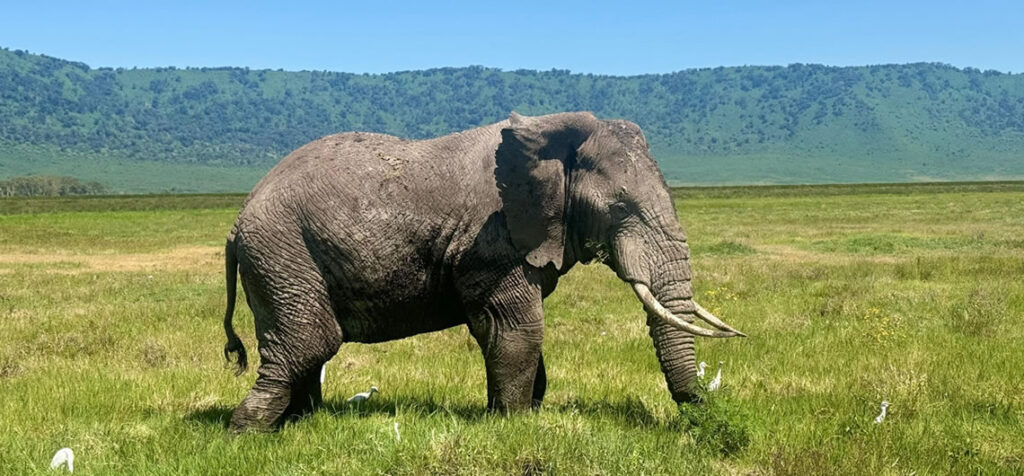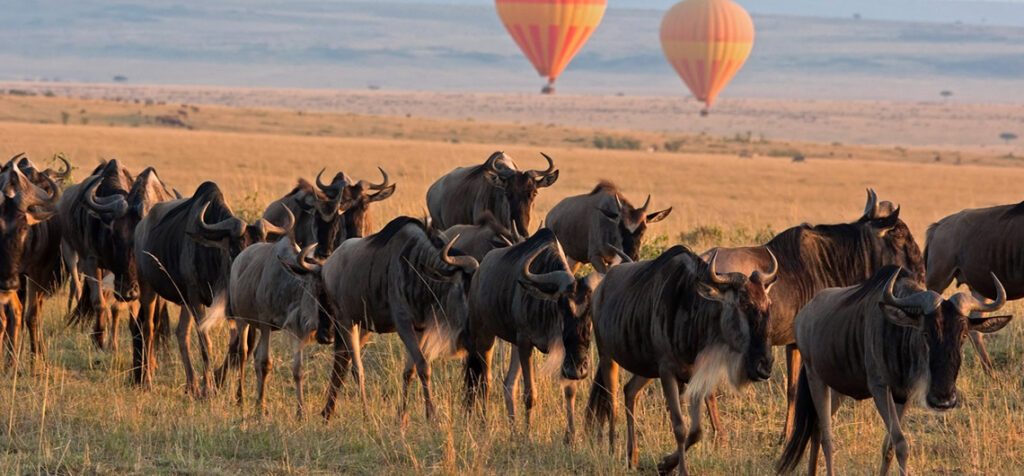The Ngorongoro Crater is a geological wonder as well as a protection for a variety of animals. This incredible natural phenomenon is a large caldera created millions of years ago by the fall of a massive volcano, resulting in a beautiful amphitheater-like landscape. The crater floor covers around 260 square kilometers and is a mosaic of meadows, woodlands, and freshwater lakes, all surrounded by towering walls reaching heights of up to 600 meters. Its distinct ecology supports a variety of flora and fauna, earning it the status of a UNESCO World Heritage Site and one of Africa’s largest conservation regions.
Beyond its geological significance, the Ngorongoro Crater is well-known for its remaining animal viewing opportunities. The crater, known as the “Eden of Africa,” is home to an estimated 25,000 large creatures, including the famed Big Five (lions, elephants, buffaloes, leopards, and rhinoceros). Tourists to the crater can go on wild safaris to see these incredible species in their natural habitat, against the backdrop of the crater’s stunning scenery. Furthermore, the crater supports a diverse range of birds, with over 500 avian species reported inside its bounds, making it an attraction for both birdwatchers and nature lovers.

Here are the quick facts about Ngorongoro Crater
- Safari Paradise
The Ngorongoro Crater is a safari paradise for those who enjoy wildlife and adventure. Guided game drives provide rare opportunities to see Africa’s renowned creatures up close, from exciting encounters with lions on the search to secure findings of elephants lounging in the waterholes.
- Great Migration

The Ngorongoro Crater is a safari paradise for those who enjoy wildlife and adventure. Guided game drives provide unusual opportunities to see Africa’s renowned creatures up close, from exciting encounters with lions on the search to secure findings of elephants lounging in the waterholes.
- Olduvai Gorge
The Olduvai Gorge, sometimes known as the “Cradle of Mankind,” is located adjacent to the Ngorongoro Conservation Area. This archeological site has some of the earliest evidence of human evolution, including remains of hominids dating back millions of years. It provides an intriguing look into our evolutionary history and the origins of humanity.
- Maasai Heritage
For decades, the Maasai people have lived in the Ngorongoro Conservation Area, coexisting peacefully with animals and keeping to their traditional pastoralist lifestyle. Their cultural past has no separation from nature, and visitors can learn about their practices, rituals, and strong connection to the earth.
- Conservation Success
The Ngorongoro Conservation Area is a remarkable achievement story for conservation efforts. The Ngorongoro Conservation Area Authority (NCAA) manages it, and it indicates how sustainable tourism and community involvement may help to preserve endangered habitats while also maintaining local livelihoods.
- Varied Ecosystems
The crater’s common topography and altitude gradients support a variety of ecosystems, including dense forests, open grasslands, and freshwater lakes. This diversity of habitats provides a haven for a wide range of plant and animal species, each of which has evolved to do well in their particular environment.
- Abundant Birdlife
In addition to its wonderful mammal residents, the Ngorongoro Crater is home to a unique avian population, with over 500 bird species reported inside its bounds. Birdwatchers can see an incredible range of feathered beauties, from colorful kingfishers to beautiful flamingos, against the backdrop of the crater’s magnificent environment.
- Wildlife Haven
The Ngorongoro Crater, dubbed the “Eden of Africa,” is well known for its abundant wildlife. It is thought to be home to over 25,000 large creatures, including all members of the renowned Big Five lions, elephants, buffaloes, leopards, and rhinoceros. Visitors visiting the crater are almost guaranteed amazing encounters with these gorgeous creatures in the wild.
- UNESCO World Heritage Site
The Ngorongoro Conservation Area, which was designated a UNESCO World Heritage Site in 1979, includes large stretches of highland grasslands, savannah, woods, and two more craters in addition to the crater itself. Its vast biodiversity and cultural value gained it this distinguished classification, which acknowledges its relevance for both wildlife protection and human heritage.
- Geological Formation
The Ngorongoro Crater is a natural marvel created millions of years ago by the fall of a gigantic volcano. This colossal event created a caldera, which is a massive, bowl-shaped depression with walls up to 600 meters high. The crater floor measures around 260 square kilometers, making it one of the world’s largest preserved calderas.
- Endangered Species
Despite its growing wildlife populations, the Ngorongoro Crater has conservation concerns, particularly for endangered species like the black rhinoceros. Poaching and habitat loss continue to threaten these iconic creatures, highlighting the necessity of continuous conservation efforts and community involvement in habitat protection.
- Cultural Experiences
The Ngorongoro Crater provides visitors with engaging cultural activities in addition to its amazing scenery. Interacting with the Maasai people offers insights into their traditional way of life, from herding cattle across the savannah to performing traditional dances around the campfire below the starlit African sky.
- Educational Opportunities
The Ngorongoro Conservation Area acts as an outdoor classroom for ecologists, students, and conservationists interested in ecosystems, wildlife behavior, and human-wildlife relationships. Its wide range of species and accessible terrain make it an attractive location for fieldwork and ecological research.
- Year-Round Destination
Unlike certain wildlife reserves, which have seasonal changes in animal sightings, the Ngorongoro Crater provides superb wildlife viewing possibilities year-round. Its temperate temperature and consistent water supplies keep wildlife in the area all year, making it a great location for safari supporters at any time.
Conclusion
In summary, the Ngorongoro Crater is testimony of the incredible richness and stunning splendor of the African continent. The crater enthralls tourists with its unsurpassed environment and engaging cultural experiences, drawing from its geological beginnings as a collapsed volcano to its designation as a UNESCO World Heritage Site and home for famous species. It is a model for protecting delicate ecosystems and assisting local populations at the same time, serving as a light of success for conservation efforts and sustainable tourist practices. A trip to the Ngorongoro Crater is a journey of discovery, connection, and profound appreciation for the wonders of nature, whether one is looking at the diversity of life within its boundaries, learning about the ancient history of the Maasai people, or just relaxing in the peace of its pristine wilderness.
